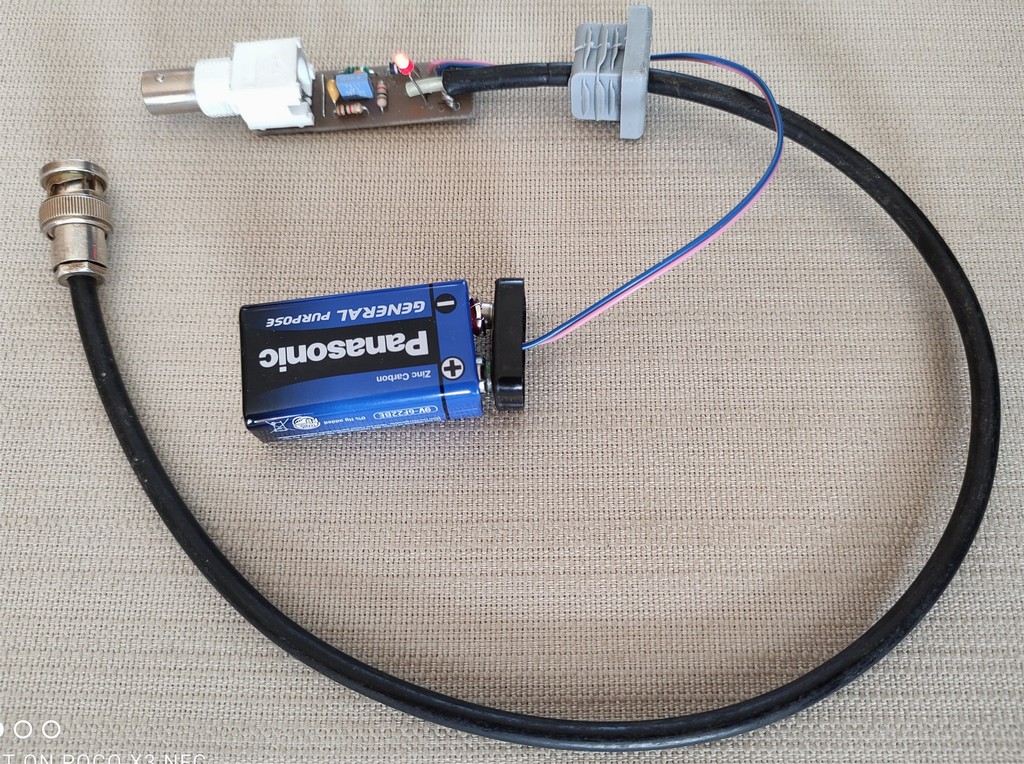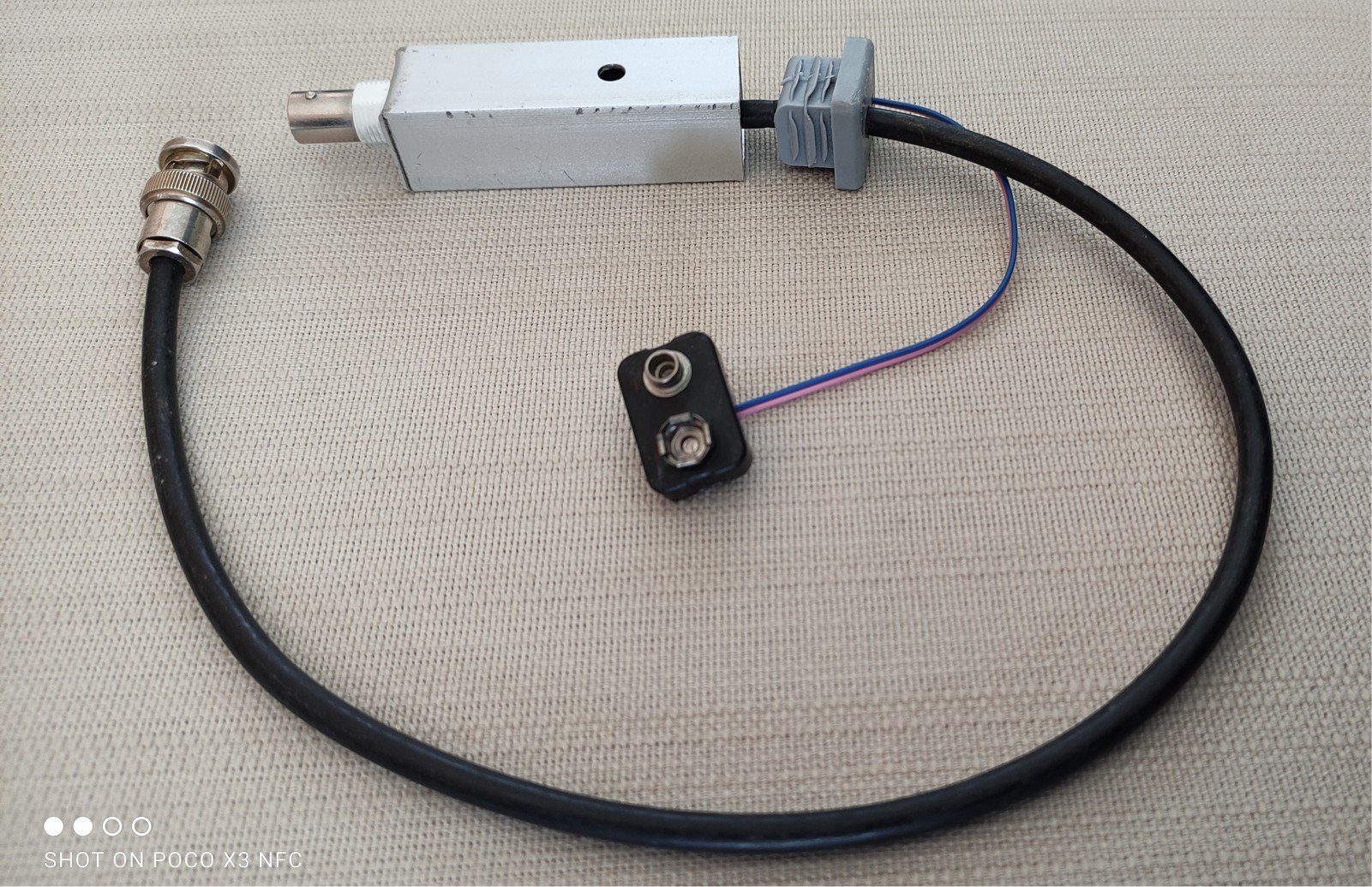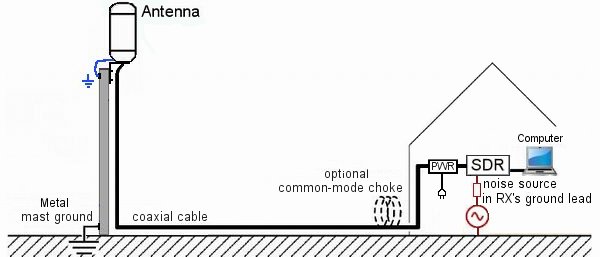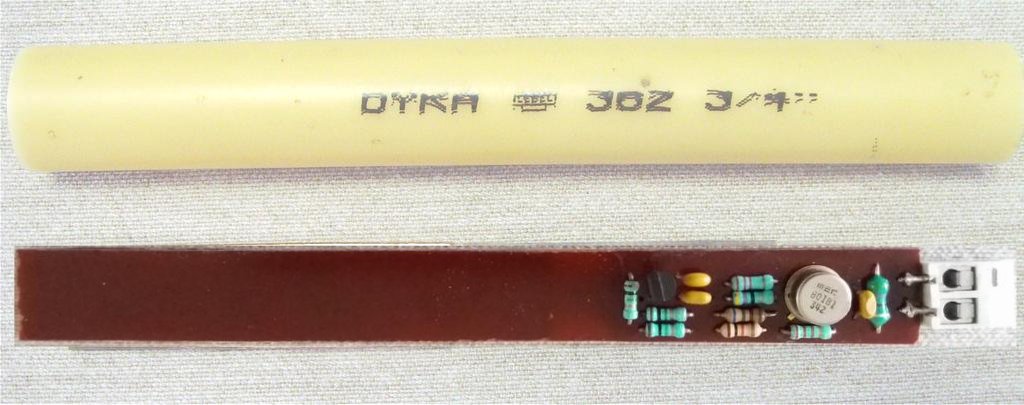|
|

Back to Homepage |
For the Basic Mini-Whip Antenna and de-noising click here
Basic Mini-Whip antenna Non-SMD (10kHz-28 MHz)
Smal design
For those who do not like to work with SMDs, there is this version of the Basic Mini-Whip, a narrow version without SMD components, so it can be placed inconspicuously.There are already countless designs and versions of the MiniWhip antenna (see my previous article: Basic Mini-Whip Antenna).
However, in a practical implementation, it is not always that easy to find a suitable housing for outdoor mounting. Sometimes they are pots, boxes, tubes and other peculiar housings, which must also be weatherproof or watertight.
I came up with the idea to miniaturize the whole thing a bit more, so that we can use
a simple construction, such as e.g. a piece of electrical PVC pipe of 3/4" (16mm) from the Hobby market, with 2 sealing caps
(for chair legs) above and below. We can easily mount these against a metal or plastic post.
See further to Fig.1. Here the Mini Whip can be fully retracted.
It is now much easier to clamp the whole outdoor house, on a metal or a PVC post, with standard 3/4" plastic brackets or clamps.
** Attention: with a metal mast, the PVC part with the antenna must protrude just ABOVE the metal mast.
The concept as with the Basic version remains the same, only the prints, apart from a few additions, have been adapted to fit directly into the tube.
The internal diameter of the electrical tube is 3/4" (16 mm).
Fig.1 The diagram of the antenna PCB and the power supply :
The Antenna Plate is 100mm x 15mm copper, on single sided copper PCB.

Click on the figure for a larger view
A quick look at the schedule:
The copper antenna plate (plate) forms a pure capacitance (4 to 6pF) with the surrounding air.
This is coupled to the gate of a J310 JFET transistor with a very small input capacitance (+/- 2 pF).
This FET has a high output impedance, and is then coupled to an HF transistor,
which makes it a low impedance of about 50 ohms.
The output of this transistor goes with a 470nF coupling capacitor to the coax antenna cable.
The coupling transistor TRW80181 is an old TO-3 VHF transistor from a cable TV amplifier. This may also be a 2N5309 or another good HF transistor.
The power supply for the antenna goes over the same coaxial cable, and is decoupled in the antenna PCB power line by a choke.
On the power supply PCB, the AC antenna signal to the output is separated from the DC power supply with a coupling capacitor of 470nF.
The strength of the antenna signal is actually the difference, measured between the signal reaching the antenna plate, and the mass of the antenna PCB.
New in this design is the extra attention to suppression.
Because there is little ground plane on the antenna PCB, it is important that the antenna PCB is grounded at the EARTH point (Earth) at the bottom of R8,
and not directly to the Output connector.
From "Earth" a separate piece of wire goes to the metal mast, or with a plastic mast, a direct wire to a pin in the ground.
A metal mast in turn is also grounded at the bottom with a pin in the ground.
The diagram also shows that an extra isolation transformer type TC4-1 has been included in the power supply section. TC4-1 is NOT a type no.
This is just an isolation transformer; a toroid for HF and with 3wdgn prim. and 4wdgn sec.
In principle, this can be omitted and wire bridges can be installed instead, but there is a chance that the interference level (jacketed currents) on the antenna will be much higher.
The torque capacitances may be 220nF or 470nF MKM or Ceramic, (the value is not very critical).
Many of these 'special' parts are available from Aliexpress.
Fig.2 The construction drawing of the antenna PCB (dimensions in mm):
Click on the photo for a larger view
The antenna print (L= 180mm), fits in a piece of PVC pipe of 3/4" (16mm), and this is 310mm long.The advantage of using 3/4" electrical conduit is that a smaller 5/8" electrical conduit fits exactly in it. See later. So:
Glue a 15 mm PVC ring (piece of 5/8 pipe) in the head of the tube, this serves as a spacer ring to protect the antenna surface against moisture.
It is better to omit a BNC connector at the antenna connection, for example, due to possible moisture problems.
Instead, the coax cable can be connected to the antenna board, e.g. screwed into a solderable PCB terminal block, as shown on the construction drawing in Fig.2, or if possible, soldered directly.
Drill a 6mm hole in the center of the bottom cover for the coax feedthrough. Coax cable RG58 (50 ohm) is 6mm thick, RG59 (75 ohm) is 7mm thick.
Then insert and slide the coax cable through the 6mm hole in the 19mm PVC sealing cap.
Then slide a piece of 120mm PVC pipe, diam. 5/8" across the cable at the bottom of the antenna. That way a piece of 12cm remains free at the bottom of the tube.
Then connect the coax to the PCB (screw or solder directly).
Slide the whole into the 3/4 tube at the bottom, up to the upper buffer ring, in order to clamp the antenna print. Close the tube with the 19mm bottom cap.
Wrap a piece of plastic insulating tape around the lower cap and the tube to prevent water seepage.
Important: the bottom piece of tube is now 12cm free to put 2 brackets or clamps on (see indication "supports" in Fig.2).
When using a metal pole, it is important to let the antenna section protrude 16 cm ABOVE the pole, and not to mount it next to it or to the side. The antenna section must be in the open air in order to receive the radio waves from all sides.
Fig.4 The print layout of the power supply PCB (the BNC on the left goes to the antenna - the right goes to the SDR receiver)
 The power PCB (dimensions are in mm) |
|
 Photo of the power supply board (without isolation transformer) |
 Photo of built-in power supply board |
Click on the photo for a larger view
The power supply PCB fits e.g. in a 19x19 mm piece of square aluminum tube from the hobby market. The length will be slightly different for everyone, depending on the BNC chassis connector used. One head-end of the tube on the BNC is folded closed after sawing off 3 side pieces of the tube (see photo on the right).
A hole (12.5 mm) is drilled on the head of this to allow the BNC chassis wire to protrude to the outside. You may need to file a little more.
Important: Where the PCB bottom with the copper side enters the tube, slide a cut 0.3 mm thick rigid piece of plastic (blister) or sheet into the tube, so that the copper side cannot make contact with the bottom of the aluminum tube.
If you have mounted an LED, you can drill a 5 mm viewing hole in the tube at the appropriate place at the top. Do this BEFORE mounting the PCB.
Between the BNC chassis and the antenna, use a long coax cable to the outside, with a BNC plug on one side (for inside). The piece of coaxial cable (bottom of Fig.4) coming from the power supply PCB, to the SDR receiver or to an HF Up-Converter, is soldered directly on the contacts of the power PCB.
You can close the other end of the square tube with a square PVC cap from the hobby market. The cable passes through a 6 mm drilled hole in the middle of the square PVC cover (see Fig.4). But put the cable through here first, before it is soldered. The power supply cable passes through a 2.5 mm drilled hole through the square cap (see Fig.4). You can replace the 9V connector with another type if you are going to use a 9V power adapter.
For a test of this antenna, check out my website for the Basic version HF Mini Whip Antenna.
Fig.5 Grounding a MiniWhip

If you want good reception, the following is very important :
This is an OUTDOOR antenna. Do not use them indoors. Even in the attic by a window, she will only perform poorly.
The electrical disturbance indoors is simply too great.
Exactly follow the connections in figure 5 to suppress the antenna. Notice that there is an additional ground wire running directly from the antenna PCB to the antenna mast.
At the bottom of the antenna mast, the mast is grounded again.
Read the article about interference and what you can do to avoid it : Interference.
Downloads:
PCB-layout download here: MiniWhip_1.0.zip
References (Maybe some are already off-line):
PA0RDT-Mini-Whip Antenna
PA4NIC MiniWhip-pagina.html
Technical pages :
DL1DBC whip/Article_pa0rdt-Mini-Whip
PA3FWM projects/miniwhip/
PA3FWM Technotes Grounding
This antenna is great for use with my SDR HF UP-convertor :
SDR Up-converter v3.0 XT_125 on1bes at Scarlet.be
on1bes at Scarlet.be 

